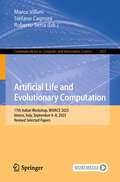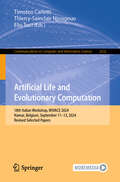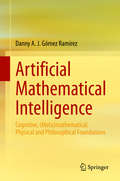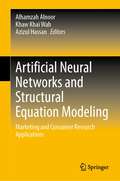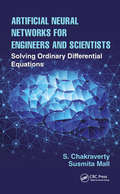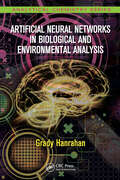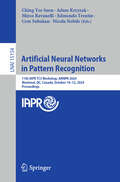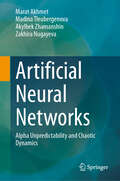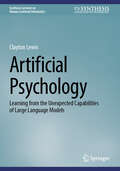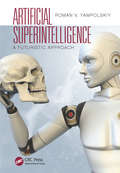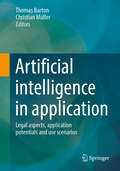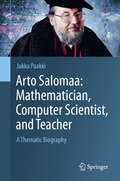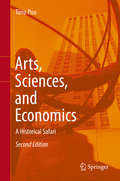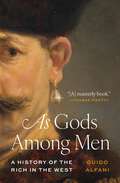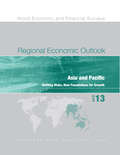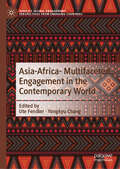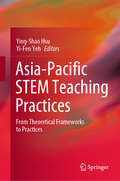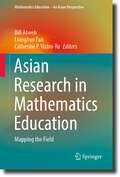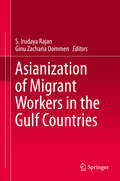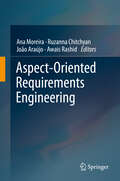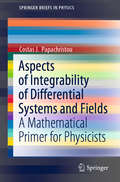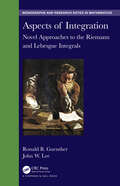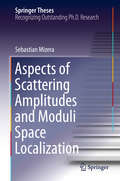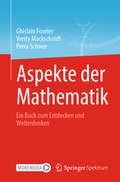- Table View
- List View
Artificial Life and Evolutionary Computation: 17th Italian Workshop, WIVACE 2023, Venice, Italy, September 6–8, 2023, Revised Selected Papers (Communications in Computer and Information Science #1977)
by Stefano Cagnoni Marco Villani Roberto SerraThis book constitutes the refereed post proceedings of the 17th Italian Workshop on Artificial Life and Evolutionary Computation, WIVACE 2023, held in Venice, Italy, during September 6–8, 2023.The 30 full papers included in this book were carefully reviewed and selected from 55 submissions. They were organized in topical sections as follows: Algorithms for complex systems, Biologically inspired models, Complex chemical systems, Adaptation and swarms, Learning, Medicine and Social systems.
Artificial Life and Evolutionary Computation: 18th Italian Workshop, WIVACE 2024, Namur, Belgium, September 11–13, 2024, Revised Selected Papers (Communications in Computer and Information Science #2532)
by Elio Tuci Timoteo Carletti Thierry-Sainclair NjougouoThis book constitutes revised selected papers from the 18th Italian Workshop on Artificial Life and Evolutionary Computation, WIVACE 2024, which took place in Namur, Belgium, during September 11-13, 2024. The 23 full papers included in this book were carefully reviewed and selected from 40 submissions.The workshop brings together computer scientists, mathematicians, biologists, psychologists, and cognitive scientists to discuss issues related to the original of life, evolution and adaption, collective and social behaviours and other topics related to the development of technological solutions inspired by biological principles.
Artificial Mathematical Intelligence: Cognitive, (Meta)mathematical, Physical and Philosophical Foundations
by Danny A. Gómez RamírezThis volume discusses the theoretical foundations of a new inter- and intra-disciplinary meta-research discipline, which can be succinctly called cognitive metamathematics, with the ultimate goal of achieving a global instance of concrete Artificial Mathematical Intelligence (AMI). In other words, AMI looks for the construction of an (ideal) global artificial agent being able to (co-)solve interactively formal problems with a conceptual mathematical description in a human-style way. It first gives formal guidelines from the philosophical, logical, meta-mathematical, cognitive, and computational points of view supporting the formal existence of such a global AMI framework, examining how much of current mathematics can be completely generated by an interactive computer program and how close we are to constructing a machine that would be able to simulate the way a modern working mathematician handles solvable mathematical conjectures from a conceptual point of view. The thesis that it is possible to meta-model the intellectual job of a working mathematician is heuristically supported by the computational theory of mind, which posits that the mind is in fact a computational system, and by the meta-fact that genuine mathematical proofs are, in principle, algorithmically verifiable, at least theoretically. The introduction to this volume provides then the grounding multifaceted principles of cognitive metamathematics, and, at the same time gives an overview of some of the most outstanding results in this direction, keeping in mind that the main focus is human-style proofs, and not simply formal verification. The first part of the book presents the new cognitive foundations of mathematics’ program dealing with the construction of formal refinements of seminal (meta-)mathematical notions and facts. The second develops positions and formalizations of a global taxonomy of classic and new cognitive abilities, and computational tools allowing for calculation of formal conceptual blends are described. In particular, a new cognitive characterization of the Church-Turing Thesis is presented. In the last part, classic and new results concerning the co-generation of a vast amount of old and new mathematical concepts and the key parts of several standard proofs in Hilbert-style deductive systems are shown as well, filling explicitly a well-known gap in the mechanization of mathematics concerning artificial conceptual generation.
Artificial Neural Networks and Structural Equation Modeling: Marketing and Consumer Research Applications
by Azizul Hassan Alhamzah Alnoor Khaw Khai WahThis book goes into a detailed investigation of adapting artificial neural network (ANN) and structural equation modeling (SEM) techniques in marketing and consumer research. The aim of using a dual-stage SEM and ANN approach is to obtain linear and non-compensated relationships because the ANN method captures non-compensated relationships based on the black box technology of artificial intelligence. Hence, the ANN approach validates the results of the SEM method. In addition, such the novel emerging approach increases the validity of the prediction by determining the importance of the variables. Consequently, the number of studies using SEM-ANN has increased, but the different types of study cases that show customization of different processes in ANNs method combination with SEM are still unknown, and this aspect will be affecting to the generation results. Thus, there is a need for further investigation in marketing and consumer research. This book bridges the significant gap in this research area. The adoption of SEM and ANN techniques in social commerce and consumer research is massive all over the world. Such an expansion has generated more need to learn how to capture linear and non-compensatory relationships in such area. This book would be a valuable reading companion mainly for business and management students in higher academic organizations, professionals, policy-makers, and planners in the field of marketing. This book would also be appreciated by researchers who are keenly interested in social commerce and consumer research.
Artificial Neural Networks for Engineers and Scientists: Solving Ordinary Differential Equations
by S. Chakraverty Susmita MallDifferential equations play a vital role in the fields of engineering and science. Problems in engineering and science can be modeled using ordinary or partial differential equations. Analytical solutions of differential equations may not be obtained easily, so numerical methods have been developed to handle them. Machine intelligence methods, such as Artificial Neural Networks (ANN), are being used to solve differential equations, and these methods are presented in Artificial Neural Networks for Engineers and Scientists: Solving Ordinary Differential Equations. This book shows how computation of differential equation becomes faster once the ANN model is properly developed and applied.
Artificial Neural Networks in Biological and Environmental Analysis (Analytical Chemistry)
by Grady HanrahanOriginating from models of biological neural systems, artificial neural networks (ANN) are the cornerstones of artificial intelligence research. Catalyzed by the upsurge in computational power and availability, and made widely accessible with the co-evolution of software, algorithms, and methodologies, artificial neural networks have had a profound
Artificial Neural Networks in Pattern Recognition: 11th IAPR TC3 Workshop, ANNPR 2024, Montreal, QC, Canada, October 10–12, 2024, Proceedings (Lecture Notes in Computer Science #15154)
by Edmondo Trentin Adam Krzyzak Mirco Ravanelli Nicola Nobile Ching Yee Suen Cem SubakanThis book constitutes the refereed proceedings of the 11th IAPR TC3 Workshop on Artificial Neural Networks in Pattern Recognition, ANNPR 2024, held in Montreal, QC, Canada, during October 10–12, 2024. The 27 full papers presented together were carefully reviewed and selected from 46 submissions. The conference focuses on: learning algorithms and architectures; applications in medical and health sciences; applications in computer vision; applications in NLP, speech, and music; applications in environmental and biological sciences.
Artificial Neural Networks: Alpha Unpredictability and Chaotic Dynamics
by Marat Akhmet Madina Tleubergenova Akylbek Zhamanshin Zakhira NugayevaMathematical chaos in neural networks is a powerful tool that reflects the world’s complexity and has the potential to uncover the mysteries of the brain’s intellectual activity. Through this monograph, the authors aim to contribute to modern chaos research, combining it with the fundamentals of classical dynamical systems and differential equations. The readers should be reassured that an in-depth understanding of chaos theory is not a prerequisite for working in the area designed by the authors. Those interested in the discussion can have a basic understanding of ordinary differential equations and the existence of bounded solutions of quasi-linear systems on the real axis. Based on the novelties, this monograph aims to provide one of the most powerful approaches to studying complexities in neural networks through mathematical methods in differential equations and, consequently, to create circumstances for a deep comprehension of brain activity and artificial intelligence. A large part of the book consists of newly obtained contributions to the theory of recurrent functions, Poisson stable, and alpha unpredictable solutions and ultra Poincaré chaos of quasi-linear and strongly nonlinear neural networks such as Hopfield neural networks, shunting inhibitory cellular neural networks, inertial neural networks, and Cohen-Grossberg neural networks. The methods and results presented in this book are meant to benefit senior researchers, engineers, and specialists working in artificial neural networks, machine and deep learning, computer science, quantum computers, and applied and pure mathematics. This broad applicability underscores the value and relevance of this research area to a large academic community and the potential impact it can have on various fields.
Artificial Psychology: Learning from the Unexpected Capabilities of Large Language Models (Synthesis Lectures on Human-Centered Informatics)
by Clayton LewisThe success of predictive large language models (PLLMs) like GPT3 and ChatGPT has created both enthusiasts and skeptics of their widespread practical applications, but this book argues that the larger significance of such models is contained in what they suggest about human cognition. To explore this potential, the book develops a thought experiment called the Prediction Room, a reference to John Searle’s influential Chinese Room argument, in which a human agent processes language by following a set of opaque written rules without possessing an inherent understanding of the language. The book proposes a new Room model—the Prediction Room with its resident Prediction Agent—generalizing the working of large language models. Working through a wide range of topics in cognitive science, the book challenges the conclusion of Searle’s thought experiment, that discredited contemporary artificial intelligences (AI), through the suggestion that the Prediction Room offers a means of exploring how new ideas in AI can provide productive alternatives to traditional understandings of human cognition. In considering the implications of this, the book reviews an array of topics and issues in cognitive science to uncover new ideas and reinforce older ideas about the mental mechanisms involved in both sides. The discussion of these topics in the book serves two purposes. First, it aims to stimulate new thinking about familiar topics like language acquisition or the nature and acquisition of concepts. Second, by contrasting human psychology with the form of artificial psychology these models exhibit, it uncovers how new directions in the development of these systems can be better explored.
Artificial Superintelligence: A Futuristic Approach
by Roman V. YampolskiyA day does not go by without a news article reporting some amazing breakthrough in artificial intelligence (AI). Many philosophers, futurists, and AI researchers have conjectured that human-level AI will be developed in the next 20 to 200 years. If these predictions are correct, it raises new and sinister issues related to our future in the age of
Artificial intelligence in application: Legal aspects, application potentials and use scenarios
by Thomas Barton Christian MüllerThe book shows application potentials of artificial intelligence in various industries and presents application scenarios on how a practical implementation can take place. The starting point is the description of legal aspects, which includes a European regulation for artificial intelligence and addresses the question of the permissibility of automated decisions. The description of various application potentials, mostly industry-related, and the presentation of some application scenarios form the focus of the topic volume. The book is based on the question of how artificial intelligence can be used in entrepreneurial practice. It offers important information that is just as relevant for practitioners as for students and teachers. This book is a translation of an original German edition. The translation was done with the help of artificial intelligence (machine translation by the service DeepL.com). A subsequent human revision was done primarily in terms of content, so that the book will read stylistically differently from a conventional translation.
Arto Salomaa: A Thematic Biography
by Jukka PaakkiThis book outlines the scientific career of Arto Salomaa, a pioneer in theoretical computer science and mathematics. The author first interviewed the subject and his family and collaborators, and he then researched this fascinating biography of an intellectual who was key in the development of these fields.Early chapters progress chronologically from Academician Salomaa's origins, childhood, and education to his professional successes in science, teaching, and publishing. His most impactful direct research efforts have been in the areas of automata and formal languages. Beyond that he has influenced many more scientists and professionals through collaborations, teaching, and books on topics such as biocomputing and cryptography. The author offers insights into Finnish history, culture, and academia, while historians of computer science will appreciate the vignettes describing some of the people who have shaped the field from the 1950s to today. The author and his subject return throughout to underlying themes such as the importance of family and the value of longstanding collegial relationships, while the work and achievements are leavened with humor and references to interests such as music, sport, and the sauna.
Arts, Sciences, and Economics: A Historical Safari
by Tönu PuuThis book deals with the economic aspects of changing attitudes in arts and sciences. The effects of the public good character of culture, along with the very long production period and lifetime for its products, are emphasized, since both contribute to the failure of normal market solutions. Embodiment of ideas and the consequences of modern reproduction technology for protection of property rights are closely examined. The evolution within arts and sciences, which often seems to return to previously scrapped ideals, is illustrated by detailed case studies, in which the importance of changing tastes, rather than progress proper, is emphasized. The author attempts an understanding for this using Darwinian evolution in combination with modern mathematical complexity theory, expressed in terms accessible to the general reader. The second edition is extended and updated especially as regards the illustration material.
As Gods Among Men: A History of the Rich in the West
by Guido Alfani"In this masterly book, [Alfani] offers an insightful long-run perspective and fascinating lessons for the future. A must-read!"—Thomas Piketty, author of Capital in the Twenty-First CenturyA sweeping narrative that shows how the rich historically justified themselves by helping their societies in times of crisis, why they no longer do, and what that may mean for social stabilityThe rich have always fascinated, sometimes in problematic ways. Medieval thinkers feared that the super-rich would act 'as gods among men&’; much more recently Thomas Piketty made wealth central to discussions of inequality. In this book, Guido Alfani offers a history of the rich and super-rich in the West, examining who they were, how they accumulated their wealth and what role they played in society. Covering the last thousand years, with frequent incursions into antiquity, and integrating recent research on economic inequality, Alfani finds—despite the different paths to wealth in different eras—fundamental continuities in the behaviour of the rich and public attitudes towards wealth across Western history. His account offers a novel perspective on current debates about wealth and income disparity.Alfani argues that the position of the rich and super-rich in Western society has always been intrinsically fragile; their very presence has inspired social unease. In the Middle Ages, an excessive accumulation of wealth was considered sinful; the rich were expected not to appear to be wealthy. Eventually, the rich were deemed useful when they used their wealth to help their communities in times of crisis. Yet in the twenty-first century, Alfani points out, the rich and the super-rich—their wealth largely preserved through the Great Recession and COVID-19—have been exceptionally reluctant to contribute to the common good in times of crisis, rejecting even such stopgap measures as temporary tax increases. History suggests that this is a troubling development—for the rich, and for everyone else.
Asia and Pacific: Shifting Risks, New Foundations for Growth
by International Monetary FundA report from the International Monetary Fund.
Asia-Afria- Multifaceted Engagement in the Contemporary World (Africa's Global Engagement: Perspectives from Emerging Countries)
by Yongkyu Chang Ute FendlerThis book provides an insight into the complex entanglements between African countries and India, China, and South Korea from multidisciplinary perspectives connecting approaches from cultural, anthropological, literary, and music studies and art history. The three parts present a regional focus, namely Africa-India, Africa-South Korea, and Africa-China while the single contributions speak to each other and offer complementary insights. At the same time, the chapters also link across the regional realms as they deal with similar topics, such as travelling music genres. In part I, for Pombo material culture is the starting point to investigate the connections between the islands of the Indian Ocean and India by questioning the construction of memory. It highlights various aspects of the multilayered history of connections between Africa, the islands, and India. Part II gathers contributions that are complimentary to each other and therefore contribute to the understanding of the complex entanglements in area studies. Part III (Africa-South Korea) explores the impact of African-American arts and artists on South Korea's popular culture as well as the changing perception of artists of African descent in visual popular culture. It shows the impact of Korean content in South Africa.
Asia-Pacific STEM Teaching Practices: From Theoretical Frameworks to Practices
by Ying-Shao Hsu Yi-Fen YehThis book offers various perspectives on the complex and crosscutting concepts of the science, technology, engineering, and mathematics (STEM) disciplines in the classroom context. Presenting empirical studies, it reveals how researchers in the Asia-Pacific Region planned and implemented STEM education in the classroom. Further, it discusses the assessment of STEM learning to clarify what important elements should be included and how researchers and educators frame and design assessment tools. The book consists of four parts: potential and trends in STEM education; teachers’ practical knowledge for STEM teaching; STEM teaching practices; and assessment of STEM learning. Providing evidence on developing curriculums, implementing instructional practices and educating classroom teachers, it is intended for readers wanting to explore STEM education from multiple perspectives.
Asian America: Sociological And Interdisciplinary Perspectives
by Pawan Dhingra Robyn Magalit RodriguezAsian Americans are the fastest growing minority population in the country. Moreover, they provide a unique lens on the wider experiences of immigrants and minorities in the United States, both historically and today. Pawan Dhingra and Robyn Magalit Rodriguez’s acclaimed introduction to understanding this diverse group is here updated in a thoroughly revised new edition. Incorporating cutting-edge thinking and discussion of the latest current events, the authors critically examine key topics in the Asian-American experience, including education and work, family and culture, media and politics, and social hierarchies of race, gender, and sexuality. Through vivid examples and clear discussion of a broad range of theories, the authors explore the contributions of Asian American Studies, sociology, psychology, history, and other fields to understanding Asian Americans, and vice versa. The new edition includes further pedagogical elements to help readers apply the core theoretical and analytical frameworks encountered. In addition, the book takes readers beyond the boundaries of the United States to cultivate a comparative understanding of the Asian experience as it has become increasingly global and diasporic. This engaging text will continue to be a welcome resource for those looking for a rich and systematic overview of Asian America, as well as for undergraduate and graduate courses on immigration, race, American society, and Asian American Studies.
Asian Research in Mathematics Education: Mapping the Field (Mathematics Education – An Asian Perspective)
by Lianghuo Fan Bill Atweh Catherine P. Vistro-YuThis book focuses on the development of research in mathematics education cultures and its products from the perspective of local educators. It consists of contributions from Mainland China, Indonesia, Korea, Macao, Singapore, the Philippines, and Turkey. This book examines the development of the culture of research in the respective countries and also reviews the research conducted in the recent past in mathematics education. It takes a critical stance through identifying the various accomplishments, and identifying challenges for the future of research in terms of its diversification and quality. Divided into two sections, the first section considers factors around the development of a research culture in the respective countries by focusing on the means used to develop research expertise and quality. The second section consists of overviews of the area of research and methodologies conducted in mathematics education in the various countries, with the intention of highlighting the research topics conducted as well as discussing omissions of such research.
Asianization of Migrant Workers in the Gulf Countries
by S. Irudaya Rajan Ginu Zacharia OommenThis edited volume contains sixteen chapters by eminent scholars on one of the largest migration corridors in the world i.e., between South and South-East Asia and the Gulf region. Asia’s trade and cultural contact with the Gulf date back to ancient historical times. Since the 1970s, the economic rise of the Gulf Cooperation Council (GCC) countries owing to the discovery of oil has inspired a huge influx of migrant workers from Asia. At present, out of roughly 15 million expatriates in the Gulf region, Asians constitute around 12 million (80 percent). The chapters in this book look at migration from countries like India, Sri Lanka, Bangladesh, Pakistan, Indonesia and Philippines to the different GCC countries. A few chapters also focus on migration from the India state of Kerala- a state where migration to the Gulf is prominent and where remittances make up over 36 percent of the state GDP. Furthermore, the issues covered range from labour practices and policies, citizenship and state protection, human rights, gender and caste as well as diaspora. This book explores the multifaceted nuances of the ‘Asia-Gulf migratory corridor’ and unearths future prospects and strategic implications. The book examines remittance behaviour, changing gender roles of immigrants, social-spatial mobility, migrant policies, human rights, sense of belonging and identity and perception, and the interaction between nationals and non-nationals. The book will be of interest to researchers in the areas of demography, migration and gender studies as well as social science researchers, policy makers, human rights lawyers, civil society institutions working on migration, Gulf studies programmes and centres on South-Asian and Middle-Eastern studies.
Aspect-Oriented Requirements Engineering
by Awais Rashid João Araújo Ana Moreira Ruzanna ChitchyanBroadly-scoped requirements such as security, privacy, and response time are a major source of complexity in modern software systems. This is due to their tangled inter-relationships with and effects on other requirements. Aspect-Oriented Requirements Engineering (AORE) aims to facilitate modularisation of such broadly-scoped requirements, so that software developers are able to reason about them in isolation - one at a time. AORE also captures these inter-relationships and effects in well-defined composition specifications, and, in so doing exposes the causes for potential conflicts, trade-offs, and roots for the key early architectural decisions. Over the last decade, significant work has been carried out in the field of AORE. With this book the editors aim to provide a consolidated overview of these efforts and results. The individual contributions discuss how aspects can be identified, represented, composed and reasoned about, as well as how they are used in specific domains and in industry. Thus, the book does not present one particular AORE approach, but conveys a broad understanding of the aspect-oriented perspective on requirements engineering. The chapters are organized into five sections: concern identification in requirements, concern modelling and composition, domain-specific use of AORE, aspect interactions, and AORE in industry. This book provides readers with the most comprehensive coverage of AORE and the capabilities it offers to those grappling with the complexity arising from broadly-scoped requirements - a phenomenon that is, without doubt, universal across software systems. Software engineers and related professionals in industry, as well as advanced undergraduate and post-graduate students and researchers, will benefit from these comprehensive descriptions and the industrial case studies.
Aspects of Integrability of Differential Systems and Fields: A Mathematical Primer for Physicists (SpringerBriefs in Physics)
by Costas J. PapachristouThis book serves as an introduction to the concept of integrability as it applies to systems of differential equations as well as to vector-valued fields. The author focuses on specific aspects of integrability that are often encountered in a variety of problems in applied mathematics, physics and engineering. The following general cases of integrability are examined: (a) path-independence of line integrals of vector fields on the plane and in space; (b) integration of a system of ordinary differential equations by using first integrals; and (c) integrable systems of partial differential equations. Special topics include the integration of analytic functions and some elements from the geometric theory of differential systems. Certain more advanced subjects, such as Lax pairs and Bäcklund transformations, are also discussed. The book is written at an intermediate level for educational purposes. The presentation is as simple as the topics allow, often sacrificing mathematical rigor in favor of pedagogical efficiency.
Aspects of Integration: Novel Approaches to the Riemann and Lebesgue Integrals (Chapman & Hall/CRC Monographs and Research Notes in Mathematics)
by Ronald B. Guenther John W. LeeAspects of Integration: Novel Approaches to the Riemann and Lebesgue Integrals is comprised of two parts. The first part is devoted to the Riemann integral, and provides not only a novel approach, but also includes several neat examples that are rarely found in other treatments of Riemann integration. Historical remarks trace the development of integration from the method of exhaustion of Eudoxus and Archimedes, used to evaluate areas related to circles and parabolas, to Riemann’s careful definition of the definite integral, which is a powerful expansion of the method of exhaustion and makes it clear what a definite integral really is.The second part follows the approach of Riesz and Nagy in which the Lebesgue integral is developed without the need for any measure theory. Our approach is novel in part because it uses integrals of continuous functions rather than integrals of step functions as its starting point. This is natural because Riemann integrals of continuous functions occur much more frequently than do integrals of step functions as a precursor to Lebesgue integration. In addition, the approach used here is natural because step functions play no role in the novel development of the Riemann integral in the first part of the book. Our presentation of the Riesz-Nagy approach is significantly more accessible, especially in its discussion of the two key lemmas upon which the approach critically depends, and is more concise than other treatments.Features Presents novel approaches designed to be more accessible than classical presentations A welcome alternative approach to the Riemann integral in undergraduate analysis courses Makes the Lebesgue integral accessible to upper division undergraduate students How completion of the Riemann integral leads to the Lebesgue integral Contains a number of historical insights Gives added perspective to researchers and postgraduates interested in the Riemann and Lebesgue integrals
Aspects of Scattering Amplitudes and Moduli Space Localization (Springer Theses)
by Sebastian MizeraThis thesis proposes a new perspective on scattering amplitudes in quantum field theories. Their standard formulation in terms of sums over Feynman diagrams is replaced by a computation of geometric invariants, called intersection numbers, on moduli spaces of Riemann surfaces. It therefore gives a physical interpretation of intersection numbers, which have been extensively studied in the mathematics literature in the context of generalized hypergeometric functions. This book explores physical consequences of this formulation, such as recursion relations, connections to geometry and string theory, as well as a phenomenon called moduli space localization. After reviewing necessary mathematical background, including topology of moduli spaces of Riemann spheres with punctures and its fundamental group, the definition and properties of intersection numbers are presented. A comprehensive list of applications and relations to other objects is given, including those to scattering amplitudes in open- and closed-string theories. The highlights of the thesis are the results regarding localization properties of intersection numbers in two opposite limits: in the low- and the high-energy expansion. In order to facilitate efficient computations of intersection numbers the author introduces recursion relations that exploit fibration properties of the moduli space. These are formulated in terms of so-called braid matrices that encode the information of how points braid around each other on the corresponding Riemann surface. Numerous application of this approach are presented for computation of scattering amplitudes in various gauge and gravity theories. This book comes with an extensive appendix that gives a pedagogical introduction to the topic of homologies with coefficients in a local system.
Aspekte der Mathematik: Ein Buch zum Entdecken und Weiterdenken
by Petra Schwer Ghislain Fourier Verity MackscheidtEntdecken Sie eine faszinierende Sammlung von Themen und Projekten aus zehn unterschiedlichen Bereichen der Mathematik: Von linearer Algebra über Geometrie und Topologie bis hin zu Graphentheorie und Kombinatorik – die Themen in diesem Buch sind vielfältig und bieten einen guten Einstieg in verschiedene Bereiche der modernen Mathematik. Elementare Vorkenntnisse in linearer Algebra und Analysis reichen völlig aus, um alle Inhalte des Buches zu verstehen. Dieses Buch bietet eine perfekte Grundlage für Proseminare, interaktive Lehrformate, Studierendenprojekte oder Abschlussarbeiten und eignet sich auch besonders für Lehramtsstudierende. Jedes der zehn Kapitel führt anhand konkreter Beispiele in die jeweils grundlegenden Konzepte und wichtigsten Fragestellungen ein. Sofern adäquat möglich werden historische Hintergründe beleuchtet und weiterführende Hinweise gegeben. Zahlreiche kurze Projektbeschreibungen regen am Ende jedes Kapitels dazu an, das Wissen zu vertiefen oder direkt anzuwenden – sei es in Seminarvorträgen, Hausarbeiten oder Gruppenprojekten. Einige Projekte werden durch ein interaktives Julia/Jupyter-Notebook ergänzt, das die Projekte um zusätzliche Visualisierungs- und Programmieraspekte erweitert. Konkrete Vorschläge für Querschnittsseminare ergänzen dieses Material. Tauchen Sie mit diesem vielseitigen und praxisorientierten Werk in die Welt der Mathematik ein!
